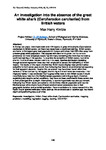An investigation into the absence of the great white shark (Carcharodon carcharias) from British waters
| dc.contributor.author | Kimble, M.H. | |
| dc.date.accessioned | 2022-12-23T19:38:19Z | |
| dc.date.available | 2022-12-23T19:38:19Z | |
| dc.date.issued | 2022 | |
| dc.identifier.citation |
Kimble, M.H. (2022) 'An investigation into the absence of the great white shark (Carcharodon carcharias) from British waters', The Plymouth Student Scientist, 15(2), pp. 239-274. https://doi.org/10.24382/ym7c-q412 | en_US |
| dc.identifier.issn | 1754-2383 | |
| dc.identifier.uri | http://hdl.handle.net/10026.1/20115 | |
| dc.description.abstract |
In the last ten years, there have been over 100 reports of great white sharks (Carcharodon carcharias) in British waters, yet there has never been a confirmed sighting. British waters are home to the largest grey seal population in Europe and is less than 200 miles away from a known great white population. This coupled with the shark’s global distribution and preference for more temperate waters has left many wondering why there has not been a confirmed sighting of this species. To examine the suitability of British waters, four white shark’s migrations were mapped spanning nine years. Species distribution modelling through boosted regression trees was then employed to assess the habitability of British waters. The results of this report showed that British waters display near-perfect habitat suitability for both sexes year-round, thus indicating that there is no environmental reasoning for their apparent absence. Despite this, an answer may have been found within their behaviour. When comparing the tagged shark’s migrations with what we know about their migratory habits, it was concluded that if a great white were to visit British waters it would most likely be a male from the Mediterranean population swimming at depth, therefore explaining why despite perfect conditions, they have not been confirmed in these waters due to their prolonged time at depth. Alternatively, a counter hypothesis was also put forward, indicating that British waters are suited to the northwest Atlantic population and that the Mediterranean white sharks have different environmental preferences due to their geographic isolation and potential speciation. Recommendations for future research into this highly cryptic species were also made, such as the continued use of satellite tags that record depth and positioning data at all times. | en_US |
| dc.language.iso | en | en_US |
| dc.publisher | University of Plymouth | en_US |
| dc.rights | Attribution 3.0 United States | * |
| dc.rights.uri | http://creativecommons.org/licenses/by/3.0/us/ | * |
| dc.subject | Investigation | en_US |
| dc.subject | British | en_US |
| dc.subject | Great white shark | en_US |
| dc.subject | Carcharodon carcharias | en_US |
| dc.subject | mapping | en_US |
| dc.subject | prediction | en_US |
| dc.subject | modelling | en_US |
| dc.subject | regression | en_US |
| dc.subject | tagging | en_US |
| dc.subject | tracking | en_US |
| dc.subject | OCEARCH | en_US |
| dc.title | An investigation into the absence of the great white shark (Carcharodon carcharias) from British waters | en_US |
| dc.type | Article | en_US |
| plymouth.issue | 2 | |
| plymouth.volume | 15 | |
| dc.identifier.doi | https://doi.org/10.24382/ym7c-q412 |



